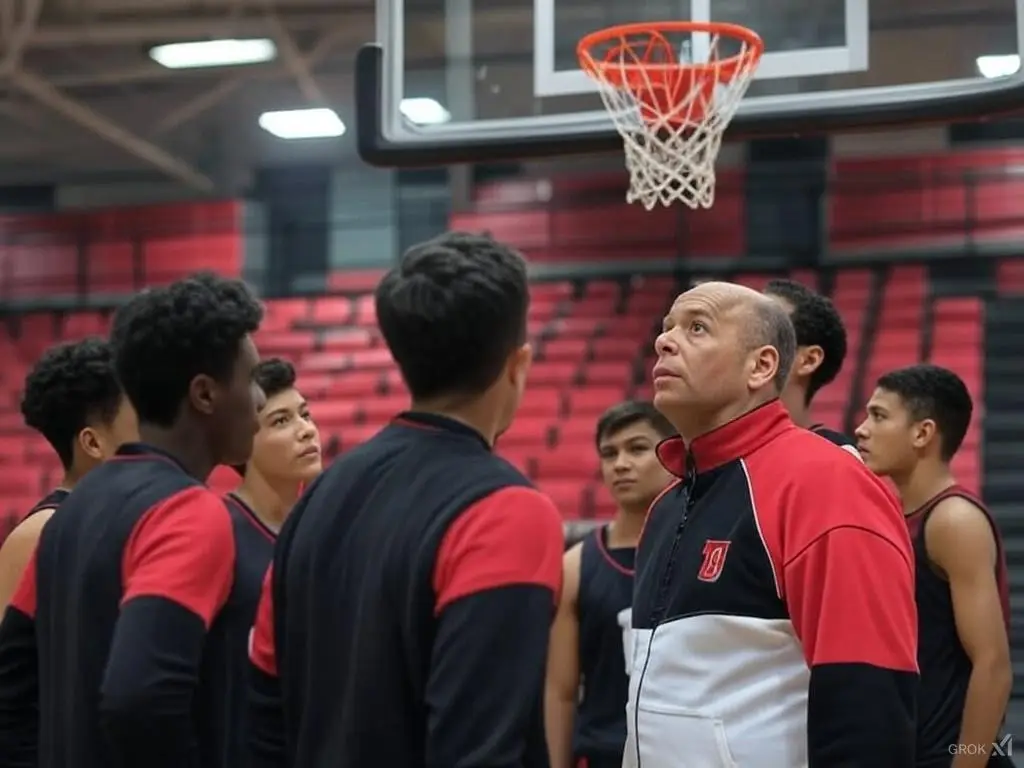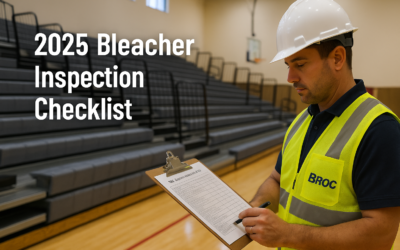Standing there with your basketball team ready to practice, but the hoop won’t budge an inch? A stuck basketball hoop can instantly derail practice sessions and games.
Whether you’re managing a school gymnasium or maintaining a home court, knowing how to lower basketball hoop height when the crank gets stuck is essential. Fortunately, several proven methods exist to fix this common problem without calling expensive repair services.
This comprehensive guide will walk you through safe, effective solutions to get your stuck basketball hoop moving again. From basic troubleshooting to advanced fixes, we’ll cover everything you need to know about unsticking that stubborn crank and getting back to the game.
Safety Precautions Before Starting
Initially, before attempting to fix a stuck basketball hoop crank, proper safety measures and preparation are essential to prevent accidents and ensure successful repairs.
Disclaimer: This article provides general information about troubleshooting and repairing stuck basketball hoop cranks. The information provided is for informational purposes only and should not be considered professional advice. Attempting repairs involves inherent risks, and you assume full responsibility for any damage or injury that may occur. If you are unsure about any procedure, or if the damage is significant, we strongly recommend contacting a qualified professional.
Required Tools and Equipment
A successful repair requires specific tools for different troubleshooting methods. Here are the essential items:
- Primary Tools:
Understanding Your Hoop’s Mechanism
Furthermore, familiarizing yourself with your basketball hoop’s basic operation is crucial. Specifically, inspect these key components:
- Height adjustment system
- Crank mechanism
- Anchor points and stability features [2]
Note: Different basketball hoops use varying mechanisms, accordingly, take time to understand your specific model’s design before proceeding with any repairs.
Protective Gear Needed
Safety equipment is essential to prevent injuries during maintenance work. Your safety gear should include:
- Thick pole padding to protect against accidental impacts [3]
- Backboard padding for additional protection [4]
- Heavy-duty work gloves
- Safety glasses
Important Safety Considerations:
The basketball court surface and surrounding area should have proper shock absorption and traction [5]. Additionally, ensure adequate lighting in your work area, especially if working during evening hours [5].
Before beginning any repair work, verify that the hoop is stable and properly anchored [6]. For portable hoops, be particularly cautious as they can become unstable in high winds or during maintenance [6].
Remember that proper safety padding acts as a protective barrier, significantly reducing the risk of injuries during both maintenance and gameplay [7]. For humid or rainy climates, take extra precautions with metal components to prevent rust and corrosion [3].
Diagnosing the Stuck Crank Issue
Understanding why your basketball hoop’s crank is stuck marks the first step toward fixing it. A systematic approach to diagnosis helps identify the exact problem and determine the most effective solution.
Common Causes of Crank Failure
Several issues can prevent proper crank operation. The most frequent problems include:
- Disengaged cotterless pin mechanism [8]
- Frozen or rusted internal components [9]
- Uneven pin compression in the adjustment system
- Mechanical misalignment of the crank assembly
Visual Inspection Steps
Follow these steps to examine your basketball hoop’s adjustment mechanism:
- Check the crank handle connection point
- Look for visible rust or corrosion
- Examine the adjustment cylinder for damage
- Verify the proper alignment of adjustment pins
- Inspect for loose or damaged components
Moreover, pay attention to any unusual sounds during operation, as grinding or clicking noises often indicate mechanical problems [10].
Testing Crank Movement
Subsequently, test the crank mechanism carefully to identify specific issues. For rear-crank systems, turn the handle clockwise to raise and counterclockwise to lower [11]. Front-crank systems operate similarly but require inserting a removable crank handle into the adjustment loop [11].
Indeed, watch for these specific indicators during testing:
- Unresponsive controls when attempting adjustment
- Inconsistent or jerky movement during operation
- Intermittent functionality while turning the crank [10]
Therefore, if the crank turns but doesn’t adjust the height, this often indicates a disconnection between the crank mechanism and the adjustment system. Nevertheless, some systems include a removable crank handle secured by a cotterless pin, which might need proper reengagement [8].
When testing movement, observe whether both adjustment pins move evenly. Uneven pin movement typically suggests internal mechanism problems [9]. For quick-release systems, verify that both pins compress simultaneously when attempting adjustment.
Quick Fix Solutions
First thing to remember, quick solutions can often resolve a stuck basketball hoop crank without extensive repairs. Let’s explore these practical fixes in order of complexity.
Lubricant Application Methods
The most effective first-line solution involves proper lubrication. Apply penetrating oil in this sequence:
- Spray WD40 or PB Blaster directly onto the stuck mechanism [12]
- Allow the lubricant to penetrate for 5-10 minutes [12]
- Attempt gentle movement of the crank
- Reapply lubricant as needed while working the mechanism
Manual Force Techniques
In essence, when lubrication alone proves insufficient, applying controlled force can help. A breaker bar offers superior leverage compared to standard tools [12]. Although this method requires careful handling, it’s often successful for moderately stuck mechanisms.
For optimal results:
- Attach the breaker bar securely to the crank mechanism
- Apply steady, controlled pressure
- Continue coating with penetrating oil while working the mechanism [12]
As opposed to using random tools, an impact driver can provide consistent force distribution when manual methods fail [12]. This tool applies equal pressure to all sides of the bolt, consequently reducing the risk of damage.
Emergency Release Options
In cases where standard methods prove unsuccessful, several emergency options exist. Important: Remove all lubricants before attempting these methods [12].
Heat application can be effective:
- Clean the area thoroughly with soapy water
- Heat the stuck component until just before glowing
- Cool with water immediately
- Gently tap sides to create movement space [12]
Certainly, as a last resort, splitting the bolt might be necessary. This method requires special tools that fit around the nut and break it in half without damaging threads [12]. Caution: Ensure the hoop is at its lowest setting and have multiple people supporting the structure before attempting this method [12].
For electrical systems, a simple power reset can sometimes resolve minor issues. Turn off power to the winch, wait several minutes, then restart the system [10]. This approach often clears temporary electrical glitches that may be affecting the mechanism’s operation.
Advanced Troubleshooting Steps
After attempting quick fixes without success, proceeding with advanced troubleshooting becomes necessary. Given that basketball hoops contain intricate mechanisms, a systematic approach to dismantling and cleaning can often resolve persistent issues.
Dismantling the Crank Mechanism
Important to realize, proper disassembly requires careful attention to detail. Follow these steps for safe dismantling:
- Document the original assembly with photos
- Remove the crank handle and outer housing
- Detach the adjustment pins carefully
- Label all parts in their removal sequence
- Place small components in labeled containers
Caution: Two people should support the backboard structure throughout this process [13].
Cleaning and Debris Removal
In fact, accumulated dirt and rust often cause mechanism failure. After all, proper cleaning requires specific materials and techniques:
- Use mild soap solution for initial cleaning [5]
- Apply rust removal products to affected areas
- Clean all moving parts thoroughly
- Avoid corrosive cleaners like bleach [14]
- Dry components completely after cleaning
Notwithstanding regular maintenance, climate conditions can significantly impact mechanism performance. In contrast to dry climates, areas with high humidity or rainfall require more frequent cleaning and maintenance [7].
Reassembly Tips
The reassembly process demands precision and attention to detail. Start by examining all components for wear or damage [15]. Pay special attention to:
- Proper thread alignment on all bolts
- Even compression of adjustment springs
- Correct positioning of limit switches
- Proper lubrication of moving parts [16]
Critical Warning: Ensure minimum pole engagement overlap of 4-5 inches (10-12.7 cm) during reassembly [17].
For optimal performance, apply lubricant designed for outdoor machinery to all moving parts [16]. After reassembly, test the mechanism through its full range of motion, listening for unusual sounds or resistance.
In areas prone to severe weather, consider installing protective covers to shield the mechanism from environmental damage [18]. Regular inspection of reassembled components helps prevent future issues and extends the lifespan of your basketball hoop system.
When to Call a Professional
Recognizing when a basketball hoop repair exceeds DIY capabilities can save time and prevent potential safety hazards. Rather than risking further damage, knowing when to seek professional assistance is crucial for maintaining your equipment’s longevity.
Signs of Serious Damage
At this point, several indicators suggest the need for professional intervention:
- Complete system instability or leaning
- Broken rim or cracked backboard
- Non-functioning actuator system
- Severe rust or corrosion
- Damaged base structure
- Persistent mechanical issues despite repairs
Critical Warning: Continuing to use severely damaged equipment poses serious safety risks and could void your warranty [19].
Warranty Considerations
Above all, understanding your warranty coverage helps protect your investment. Most manufacturers offer specific warranty terms:
- Document the original purchase with proof of receipt [1]
- Photograph any damage or defective parts
- Contact manufacturer’s customer service
- Submit warranty claim within specified timeframe
- Maintain all correspondence records
Primarily, warranties exclude damage from:
- Abuse or misuse
- Improper installation
- Unauthorized modifications
- Environmental factors [20]
For the purpose of warranty claims, manufacturers typically respond within 3-5 business days [1]. Altogether, warranty coverage varies by brand:
Finding Qualified Repair Services
Coupled with warranty considerations, selecting the right repair service ensures quality results. Professional technicians can address:
- Complex mechanical issues
- Parts replacement under warranty
- System reinstallation
- Structural repairs
- Safety compliance checks [3]
In addition to technical expertise, look for repair services that:
- Provide detailed cost estimates
- Offer written guarantees
- Maintain proper credentials
- Have positive customer reviews
- Demonstrate experience with your specific model
Important Safety Note: Professional installation is particularly crucial for warranty-covered parts, as improper installation may invalidate future claims [22].
When selecting a service provider, verify they:
- Hold appropriate certifications
- Carry liability insurance
- Provide detailed documentation
- Use manufacturer-approved parts
- Follow safety protocols [23]
Professional technicians should perform thorough inspections before beginning repairs. This includes:
- Evaluating structural integrity
- Testing mechanical components
- Assessing safety features
- Identifying potential hazards
- Documenting existing damage [10]
Remember that qualified professionals can often identify underlying issues that might not be apparent during basic troubleshooting. They possess specialized tools and expertise to:
- Diagnose complex problems
- Implement lasting solutions
- Ensure proper system operation
- Maintain warranty compliance
- Document all repairs properly [3]
Ultimate Solution: Retrofit to Keyed Switch Winch System
While the solutions above can address a stuck crank, for a long-term, user-friendly option, consider retrofitting your existing basketball hoop to a keyed switch winch powered retractable system. This upgrade offers several advantages:
- Effortless Operation: A simple turn of the key raises or lowers the hoop with minimal effort, ideal for quick adjustments during practices or games.
- Enhanced Safety: Keyed switch systems eliminate the risk of crank accidents, especially beneficial for situations with unsupervised use.
- Improved Durability: Winch mechanisms are generally more robust than manual crank systems, reducing the likelihood of future malfunctions.
- Modernized Convenience: A powered system adds a touch of sophistication and simplifies height adjustments for players of all ages.
Important Considerations:
- Compatibility: Ensure the chosen winch system is compatible
Conclusion
Basketball hoop maintenance requires careful attention to safety and systematic problem-solving. Armed with the right tools and knowledge, many stuck crank issues can be resolved through proper diagnosis and targeted solutions.
Successful repairs start with basic troubleshooting steps before moving to advanced techniques. Though DIY fixes often work, recognizing situations that demand professional intervention helps prevent further damage and maintains equipment safety.
Remember to document all repair attempts and keep warranty information readily available. Regular maintenance checks, combined with prompt attention to minor issues, will extend your basketball hoop’s lifespan and ensure safe, uninterrupted gameplay for years to come.
Most importantly, prioritize safety throughout any repair process. Whether attempting DIY solutions or seeking professional help, proper precautions and manufacturer guidelines should guide every maintenance decision.
References
[1] – https://www.spalding.com/customer-service/general-help/warranty-information.html?srsltid=AfmBOoqQ3cTLSYhIs20KWliftcMWUkTMIXD6uz0yMoWSsQkKharei30F
[2] – https://ie-sports.com/blogs/news/the-ultimate-guide-to-basketball-hoop-parts-and-accessories?srsltid=AfmBOorASa4eGf4ti8VSsZ5bwxLe0q_VZYZmFgnJKGSWjJ-OgwTxGTGq
[3] – https://serviceconnection.pro/ServiceRequest/BasketballGoalRepair
[4] – https://www.firstteaminc.com/basketball-equipment/safety-padding
[5] – https://www.goalrilla.com/pages/faq?srsltid=AfmBOooVIYM9M0-TZC_jgM8Zs8IAFz6agu5RC-ZZbqk7CAp4yHyX-WQv
[6] – https://www.breakthroughbasketball.com/hoops/hoops-guide.html
[7] – https://www.goalrilla.com/blogs/news/maintaining-your-basketball-equipment?srsltid=AfmBOoo9E81CQhSooYraoFqdthOtlwIe2dY_LY5oTCn_NYuNk4c12Jv3
[8] – https://www.adjustablebasketballgoals.com/ironclad-basketball-goal-features/easy-crank-adjustment?srsltid=AfmBOoo-M6PJamUnUKNGbBrJ2ds9XNyZfub4fhAM9kyhimeuv54kcwJE
[9] – https://www.reddit.com/r/fixit/comments/icv5da/i_have_an_adjustable_basketball_hoop_that_wont/
[10] – https://brocllc.com/troubleshooting-guide-what-to-do-when-your-basketball-backstop-wont-go-up-or-down/
[11] – https://www.firstteaminc.com/articles/how-to-adjust-basketball-goal-height
[12] – https://www.goalrilla.com/blogs/news/loosening-goalrilla-bolts-and-other-hardware?srsltid=AfmBOoq9TAGC_sSSfGSHuihsrYTCWLdDANN8ljALSc-y_eof3RPmO6gG
[13] – https://www.youtube.com/watch?v=GWyjAhGrH00
[14] – https://qualityhoops.com/blogs/news/tips-maintaining-your-basketball-hoops?srsltid=AfmBOopfo5Cpjh8y2WtKJTd1_IeJhTkerrI0xOO3YINMqk_M0S3I2QOq
[15] – https://basketballgoalstore.com/files/Signature_Int_AllAmerican_AllStar_1_13_2015.pdf?srsltid=AfmBOopBANnrQCeXJTaS5VsC3iN3OfPazjBGT-wVGArVBsLiXr7yxYrQ
[16] – https://joyfulpeter.com/blogs/news/essential-basketball-hoop-maintenance-checklist?srsltid=AfmBOooGL-DuJf1HQwa_I4V8Nf1DGF0dlqB8rzTIX0fdHkXSbUJTVHn_
[17] – https://cdn.spalding.com/manuals/M7B60E00.pdf
[18] – https://www.goalrilla.com/blogs/news/maintaining-your-basketball-equipment?srsltid=AfmBOorn6JpfhNOk5eqCZqLoGDACNRLzytSpdD3q5XJLziW0x_qChlP9
[19] – https://qualityhoops.com/blogs/news/4-signs-your-basketball-training-equipment-need-replacing?srsltid=AfmBOoq7Y-DmpAb34HjLKjyG_KLNz93YvdWmQHMc4wyOxdxrhquZzSnn
[20] – https://basketballgoalstore.com/wp-content/docs/basketball-warranty.pdf?srsltid=AfmBOoq5EVA_NpFGboDc-KIrOlvUQ4UaJfLEwfS_xoENGAOIcNw2xUgp
[21] – https://www.competitiveedgeproducts.com/Basketball-Hoop-Purchasing-Guide-Warranty-Options_b_138.html?srsltid=AfmBOoqF22SMKqo8p9ivJ9fS6bOiDc8v2UMzEDWkClZP-nrm5cuKDGYq
[22] – https://www.goalrilla.com/blogs/news/maintaining-your-basketball-equipment?srsltid=AfmBOorIZyBmSsB3HneZfOqAoz85vDE4DpXJ-2u9fMfX6YGYZXKFZvUB
[23] – https://homeguide.com/basketball-hoop-installation




